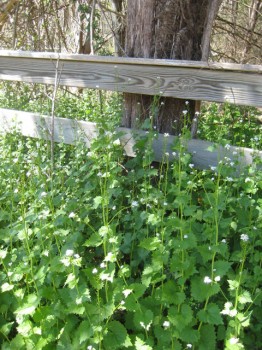
“There’s a reason why the pre-Columbian population of Colorado was low,” wild plants author Sam Thayer once wrote me, referring to the relative lack of edible wild plants in this semi-arid land compared to lusher parts of the country. How dare he? I recall thinking—though truth be told, here at 11,000 feet in the Colorado High Country, the new spring growth is still less than an inch tall; meanwhile the rest of the country is happily chatting it up about their bountiful spring forage, whether dock and dandies, redbud flowers and milkweed shoots, chickweed and sorrel, and so forth.
Honestly, though, I’m not sure I could handle the abundance.
Take my recent New England trip for example. I arrived in Connecticut mid-April, just as the trees were newly leafing out. One walk with mom down our old country road renders me speechless. There are so many plants I want to try—plants I recognize from my books, plants that nearly every other forager knows well and uses often, plants that I have not had opportunity to try since Wild Food Girl was born.
I conclude that I need a few years out east, not two weeks interspersed with family visits, to get down and dirty with all these wild plants. Especially when my 7-year-old niece purportedly complained to her mother: “With all the wonderful plants in New Hampshire, how will I be able to get enough time to play with Aunt Erica since she loves plants so much?”
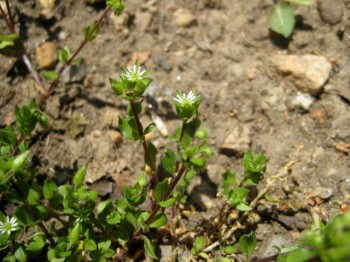
A Survey of Spring Edibles in the Northeast
Instead of going into great detail on any one plant, then, what follows is a survey of some of the edible wild plants I saw and tasted on my April 17- May 1 trip. The range is eastern Connecticut, southern – mid New Hampshire, and Troy, New York.
Understand that I have limited experience with some of these plants. This is not meant to be a guide to identification. It is always expedient to check and double check ID’s in multiple guidebooks prior to tasting. Just the other day a reader admitted to tasting a toxic plant she was unsure about, and then experiencing nausea and dizziness. Heavens to Betsy! Please be prudent! Your safety depends on it!
Parents Enjoy Plants More Than Progeny
My parents have been skeptical of my wild food creations for years, surveying both me and the meals askance, then tasting but the smallest bit and pushing away their plates. In that light it’s all the more surprising that on this trip, both mom and dad enjoyed two wild plants more than I did.
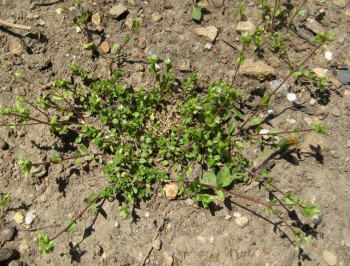
The first was chickweed (Stellaria sp.), the small plant that is so ubiquitous as to have escaped my identification until this trip. Newly aware, I found it in mom’s Connecticut rock garden, my sister’s New Hampshire vegetable garden, and pretty much everywhere else I looked.
The master northeastern forager, “Wildman” Steve Brill, gives some excellent identifying features for this prostrate, spreading plant, including the exhibition of “tiny white flowers 1/8 inch across, with 5 petals so deeply cleft they look like 10,” the “tiny, pointed, oval, untoothed leaves, 1/2 to 1 inch long” which grow in opposite pairs, and the fact that one “fine line of hair extends along the length of the slender, delicate stem.”
He cautions not to mistake chickweeds for “poisonous spotted spurge (Euphorbia maculata)” or “non-edible matted doorweed or oval-leaf knotweed (Polygonum arenastrum). See his site for details.
Chickweed is edible raw or cooked—leaves, stems and all. I collected a bunch, chopped fine and boiled for 5-10 minutes, then served with butter and salt as a side dish. I found it tough and hard to chew, concluding that perhaps I had collected specimens that were too mature. Mom and dad, on the other hand, gobbled theirs right up and pronounced it good and not the least bit tough. Am I getting snooty about wild plants in my old age? I who once declared that I’d like every wild plant I ate, no matter what?
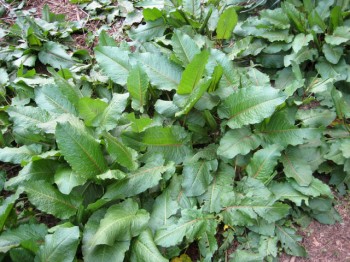
Bitter dock (Rumex obtusifolius) was next up. Although I have experience eating curly dock (R. crispus), narrow dock (R. triangulivalvis / R. salicifolius) and what I now believe to be Western dock (R. occidentalis), this was my first trial with bitter dock, and I found it to be—you guessed it—rather bitter.
Bitter dock is distinguished from other docks by its “broad, heart-shaped leaves and the coarsely toothed margins of the valves on its fruit,” according to Thayer (2010). I have also noticed a tendency for the leaf midribs to be reddish.
Following my modus operandi for other docks, I collected only new, unfurling or recently unfurled leaves, including leaf stems, then chopped and sautéed with garlic in olive oil before tasting. Whoa Nelly was that batch bitter! I added chopped carrots to balance the bitter with sweet, but I still couldn’t handle eating it. Undeterred, mom set about flavoring the dish with honey and curry, dancing around the kitchen and exuding real joy over having a new ingredient to play with. I’ll say it’s a wonderful thing to see mom with all this new time on her hands, but I’m not sure how I feel about her upstaging me in the wild plants cooking arena.
Anyway, mom’s curried bitter dock came out decent. I ate some, even helped myself to seconds. My uncle ate some too, and later, upon a second cooking attempt, dad decided it would make a good addition to stuffing.
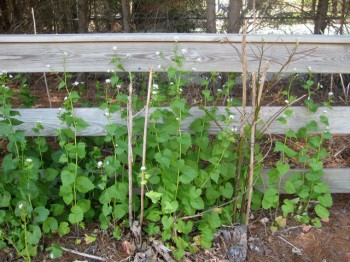
Don’t Be Fooled By the Pretty Flowers
Don’t be fooled by the pretty flowers, as has been my friend’s mom in Troy, New York who is blissfully happy to let this Eurasian invader spread about her yard, ruining everything. Garlic mustard (Allaria petiolata) is a nasty invader that ranges deep into virgin forests and conquers natural habitats, decimating native plants in the process. This stuff is everywhere I looked—all over Connecticut and New Hampshire, even in my parents’ backyard. To prevent its spread, dispose of it prior to flowering.
In his 2006 Conservation in Practice article, “Bon Appetit,” [PDF download], Joe Roman makes a case for encouraging humans to develop an appetite for unwanted invasive species. “Sure, fighting invaders requires a killer appetite, but just look at our track record: Atlantic cod, bison, manatees, and Pismo clams have all but disappeared under the weight of human demand,” he writes. “So why not put our destructive streak to good use for a change?” Based on this idea, Roman created Eat the Invaders, a site that outlines edible invaders for folks interested in joining the “invasivore” movement.
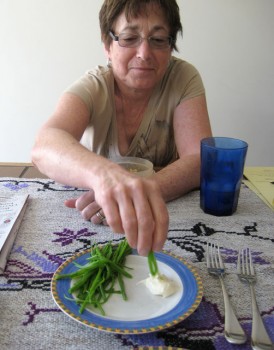
Thayer includes a chapter on garlic mustard in Nature’s Garden (2010). Though he admits to being unable to stomach the mature leaves, he recounts success with steaming or boiling the young, not-yet-flowering shoots. I tried this with our backyard batch, then served it with mayonnaise for dipping. I wish I had gotten a photo of the look on my mother’s face, because it screwed up something fierce before she spit the offending ball of yuck out onto her plate.
I emailed Sam: “The garlic mustard stalks that I ate, although not yet flowering, were icky. Growing conditions I guess. It’s been dry here for a while so I’m thinking they grew slowly and came out extra pungent.”
He emailed back: “Maybe you just don’t like garlic mustard.”
Again my reaction is this: How dare he?
On the flip side, “Wildman” Steve Brill was rather enthusiastic when I bothered him on Facebook about garlic mustard. “It’s very strong-flavored,” he admitted. “I use it sparingly in salads and vegetable recipes, and purée it into pesto and spreads.” He also said that it’s “loaded with nutrients” and invited readers to find out more—both about the plant’s nutritional content as well as cooking ideas—on his Wild Edibles iPhone app, updated April 27, 2012.
Man, I gotta get me one of these iMachines.
In the meantime, maybe I can convince mom to put her cooking skills to work to come up with some use for garlic mustard that she and I will not both detest. After all, if it’s wild, I am committed to liking it.
Okay I’m ending Part I right here at 1,200 words. Thanks for reading and please stay tuned for Part II of WFG’s East Coast Foraging Adventure!
NOTE: This entry updated 5.8.12 with a closer-to-correct version of my niece’s quote. Thanks sis!

We have more wild edibles here than you can find, harvest and eat in a season. A true treasure trove from forests full of mushrooms, ramps and day lilys to a seascape with wild rose hips, seaweed and beach peas with burdock, cattails, and purselane in between! Love the entry – can’t wait for the rest!
PS: Thanks so much for the link to the app – it looks wonderful! I’ve been wanting a good one for such a long time!!
Hey,
I just wanted to comment on your garlic mustard – I’ve been eating it all spring but didn’t know what it was called (just that it was edible). I’ve been blanching, chopping (+/- food processing), and then mixing with eggs, ricotta, seasonings, and flour. I’ll then freeze spoonfuls of this goop individually, nuking them in the microwave to reheat and then pan-frying in butter.
They are DELICIOUS! If you use regular flour, you should be able to plop these spoonfuls (before freezing) into boiling water similar to gnochi, but I’m using rice flour, which doesn’t provide any of that nice gluten-glue: hence nuking and pan-frying.
I’m looking forward to eating them all winter (I have to keep making more as I keep eating them!).
@Crystal: That sounds insane! Okay, I’ll have to try it. Are you using leaves or stems or both? And just so I understand: The freeze/nuke/pan fry process is necessary if you want to use rice flour? Or is the freezing part just for storage and the nuke/pan fry alone compensates for lack of gluten?
@Christen: Thanks! Sometimes I miss living by the seacoast.
I finally updated with lots of pix! http://clstal.tumblr.com/tagged/garlicmustard
The freezing/lots of eggs is because the texture is all wrong for real gnudi or gnocchi: way too wet, and with no body. The first time I made this I tried boiling like gnocchi – it didn’t work well, they ended up near-dissolving in the water and not having a lot of flavor.
I figured if I added more egg white, the protein would keep them together when heated, but only if I could get it into the pan in one piece: hence the freezing. The nuking is simply because I was a little worried about going from freezer to pan-fry and risking a raw center or overcooked exterior (I think this is paranoia on my part, but I’m working with a new stove that runs much hotter than the last one)
If you can eat gluten, you could follow the fat-of-the-land recipe for wild nettle gnudi to the letter (I link to it on tumblr), subbing garlic mustard for the nettles, and I bet it would be *delish*!
You have me very excited about gnocci. Never made it before. Will report back!
Crystal: I made gnocci with garlic mustard (& wheat flour) and I love it! Which means I DO like garlic mustard, thank goodness. It doesn’t grow up here so I used some dried garlic mustard leaves that I brought west from CT. I crumbled them into spice and mixed that into the potato/eggs. Mmm! Thanks for the ideas!
Excellent – glad you enjoyed it!
I did an undergraduate thesis on garlic mustard and wanted to point out why people may be having poor experiences with it. With garlic mustard only the first years growth is edible. Garlic mustard is a biennial plant, with the tall flowering stalk only growing in the second year. It is easy to identify the plant by the stalk, but when actually harvesting it, look around the bases of the stalks and edges of the patch for the “basal rosettes”. These are a pair of leaves, that look just like the leaves on the stalks, but they protrude from a single little stem and are close to the ground. Just pluck them up and you can trim the roots at home. When I’ve harvested this its been delicious in pesto and salads, and definitely not bitter at all.
Hi Tom, That sounds like an interesting project! Were you coming from an invasive species perspective with it, or edibility?
I’m not sure bitter is how I’d describe some of my initial, less pleasant tests with garlic mustard; maybe “strong” would be a better word…
As far as the “only the first years growth is edible,” what is your source on that? I’ve read many authors who eat the second year’s growth too…though I’m looking forward to trying the first year plants now to see if I like those guys any better.
Thanks for contributing!
Hey readers: Just in case you’re missing my weird sense of humor, the joke’s kind of on me in this entry, and certainly not on Sam Thayer, who is totally my hero and a good pen pal friend to boot. You see, the rational part of me agrees with Sam that if something’s gross, it’s gross, and that if a land is not lush, it’s not lush. But still I try, which is why I think it’s funny and that sometimes I’m a big dork for doing what I do. Hopefully everyone can rest much easier now that we’ve cleared that up.
Hi 🙂 I just wanted you to know I really enjoy your website and your composition. You’ve helped ease my mind about my trip too New Hampshire. I don’t plan on “Going native” so to speak, but I have ptsd and therefore i am quite nervous about not knowing the wild edibles like I do in my lovely home state of West Virginia.
Hi Zachary, thanks for the kind words. I love New Hampshire and hope that you do too. Are you moving there or just visiting?